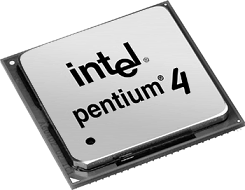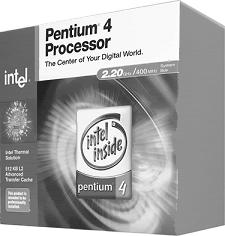Intel Pentium 4 Processors
The Pentium 4 was introduced in November 2000 and represents a new generation in processors. If this one had a number instead of a name, it might be called the 786 because it represents a generation beyond the previous 686 class processors.

The main technical details for the Pentium 4 include
-
Speeds range from 1.3GHz to 3.2GHz and beyond.
-
42 million transistors, 0.18-micron process, 217 sq. mm die (Willamette).
-
55 million transistors, 0.13-micron process, 131 sq. mm die (Northwood).
-
Software compatible with previous Intel 32-bit processors.
-
Processor (front-side) bus runs at 400MHz, 533MHz, or 800MHz.
-
Arithmetic logic units (ALUs) run at twice the processor core frequency.
-
Hyper-pipelined (20-stage) technology.
-
Very deep out-of-order instruction execution.
-
Enhanced branch prediction.
-
20KB L1 cache (12KB L1 execution trace cache plus 8KB L1 data cache).
-
256KB or 512KB of on-die, full-core speed 128-bit L2 cache with eight-way associativity.
-
L2 cache can handle up to 4GB RAM and supports ECC.
-
SSE2—144 new SSE2 instructions for graphics and sound processing.
-
Enhanced floating-point unit.
-
Multiple low-power states.
Intel has abandoned Roman numerals for a standard Arabic numeral 4 designation. Internally, the Pentium 4 introduces a new architecture Intel calls NetBurst microarchitecture, which is a marketing term and not a technical term. Intel uses NetBurst to describe hyper-pipelined technology, a rapid execution engine, a high-speed (400MHz, 533MHz, or 800MHz) system bus, and an execution trace cache.
The hyper-pipelined technology doubles the instruction pipeline depth as compared to the Pentium III, meaning more and smaller steps are required to execute instructions. Even though this might seem less efficient, it enables much higher clock speeds to be more easily attained.
The rapid execution engine enables the two integer arithmetic logic units (ALUs) to run at twice the processor core frequency, which means instructions can execute in half a clock cycle. The 400MHz/533MHz/800MHz system bus is a quad-pumped bus running off a 100MHz/133MHz/200MHz system clock transferring data four times per clock cycle.
The execution trace cache is a high-performance Level 1 cache that stores approximately 12k decoded micro-operations. This removes the instruction decoder from the main execution pipeline, increasing performance. Of these, the high-speed processor bus is most notable.
Technically speaking, the processor bus is a 100MHz, 133MHz, or 200MHz quad-pumped bus that transfers four times per cycle (4x), for a 400MHz, 533MHz, or 800MHz effective rate. Because the bus is 64 bits (8 bytes) wide, this results in a throughput rate of 3200MBps, 4266MBps, or 6400MBps.
The throughput of the Pentium 4's processor bus is an exact match for the most common types of RDRAM and DDR SDRAM memory. The use of dual-channel memory means that modules must be added in matched pairs.
Dual banks of PC1600, PC2100, or PC3200 DDR SDRAM are less expensive than equivelant RDRAM solutions, which is why virtually all newer chipsets—including the 865 (Springdale) and 875 (Canterwood)—support DDR SDRAM only for the Pentium 4.
In the new 20-stage pipelined internal architecture, individual instructions are broken down into many more sub-stages, making this almost like a RISC processor. Unfortunately, this can add to the number of cycles taken to execute instructions if they are not optimized for this processor.
Early benchmarks running existing software showed that existing Pentium III or AMD Athlon processors could easily keep pace with or even exceed the Pentium 4 in specific tasks; however, this is changing now that applications are being recompiled to work smoothly with the Pentium 4's deep pipelined architecture.
The Pentium 4 initially used Socket 423, which has 423 pins in a 39x39 SPGA arrangement. Later versions used Socket 478, which has additional pins for future and faster variations of the chip.
The Celeron was never designed to work in Socket 423, but Celeron versions are available for Socket 478, allowing you to purchase a low-cost Socket 478–based system. Voltage selection is made via an automatic voltage regulator module installed on the motherboard and wired to the socket.
Memory Requirements
Pentium 4–based motherboards use either RDRAM or DDR SDRAM memory, depending on the chipset. The RDRAM boards use the same Rambus RDRAM RIMM modules introduced for use with some of the chipsets used in Pentium III motherboards.
However, the dual RDRAM channels the Pentium 4 uses require you to install pairs of identical modules (called RIMMs). Pentium 4 motherboards that use RDRAM accept either one or two pairs of RIMMs. Both pairs of memory must be the same speed, but need not be the same size.
Whereas most initial Pentium 4 motherboard chipsets supported only RDRAM memory, most newer chipsets are available that support more standard memory, such as SDRAM or DDR SDRAM. Since Intel's contract with RAMBUS expired in 2001, DDR SDRAM has become Intel's preferred memory type for mainstream systems.
Power Supply Issues
The Pentium 4 requires a lot of electrical power, and because of this, most Pentium 4 motherboards use a new design voltage regulator module that is powered from 12V instead of 3.3V or 5V, as with previous designs. By using the 12V power, more 3.3V and 5V power is available to run the rest of the system, and the overall current draw is greatly reduced with the higher voltage as a source.
PC power supplies generate a more than adequate supply of 12V power, but the ATX motherboard and power supply design originally allotted only one pin for 12V power (each pin is rated for only 6 amps), so additional 12V lines were necessary to carry this power to the motherboard.
The fix appears in the form of a third power connector, called the ATX12V connector. This new connector is used in addition to the standard 20-pin ATX power supply connector and 6-pin auxiliary (3.3/5V) connector. Fortunately, the power supply itself won't need a redesign; there is more than enough 12V power available from the drive connectors.
To utilize this, companies such as PC Power and Cooling sell an inexpensive ($8) adapter that converts a standard Molex-type drive power connector to the ATX12V connector. Typically, a 300-watt (the minimum recommended) or larger power supply has more than adequate levels of 12V power for both the drives and the ATX12V connector.
If your power supply is less than the 300-watt minimum recommended, you need to purchase a replacement; some vendors now sell an off-the-shelf ATX12V ready model or one that uses the adapter mentioned previously. Cooling a high-wattage unit such as the Pentium 4 requires a large active heatsink.
These heavy (sometimes more than 1 lb.) heatsinks can damage a CPU or destroy a motherboard when subjected to vibration or shock, especially during shipping. To prevent this, Intel's specifications for Socket 423 added four standoffs to the ATX chassis design flanking the Socket 423 to support the heatsink retention brackets.
These standoffs enabled the chassis to support the weight of the heatsink instead of depending on the motherboard, as with older designs. Vendors also used other means to reinforce the CPU location without requiring a direct chassis attachment. For example, Asus' P4T motherboard was supplied with a metal reinforcing plate to enable off-the-shelf ATX cases to work with the motherboard.
Socket 478 systems do not require any special standoffs or reinforcement plates; instead they use a unique scheme in which the CPU heatsink attaches directly to the motherboard rather than to the CPU socket or chassis. Motherboards with Socket 478 can be installed into any ATX chassis—no special standoffs are required.
Socket 423 and 478 versions of the Pentium 4 use special heatsinks that, as noted previously, have different designs. If you purchase the shrink-wrapped or "boxed" processor, you get an Intel-specified high-quality heatsink in the box with the process.

In addition, you get a 3-year warranty with Intel, making the boxed version ideal for upgraders and system builders. Because of the included heatsink and warranty, I highly recommend purchasing only boxed processors instead raw OEM processors for upgrades or building a new system.